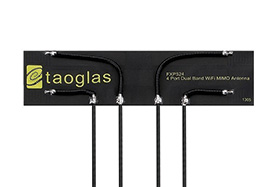

The FXP.524 Venti antenna is a 4-in-1 MIMO, flexible PCB monopole type antenna. Made by Taoglas, the antenna has excellent efficiency and isolation performance for dual-band Wi-Fi applications.
It has over 40% efficiency in the 2,4 GHz bands and over 50% in the 5 GHz bands. Featuring a low-profile height of only 0,15 mm, the FXP.524 is an ideal solution for maintaining high performance while fitting into narrow spaces such as plastic enclosures for laptops, tablets, routers and other Wi-Fi applications.
The antenna has been designed in a flexible material with a rectangular form factor and cable connection for an easy installation. The antenna comes with double-sided 3M tape for easy and robust ‘peel and stick’ mounting. The antenna cables feature IPEX connectors for easy installation. Customised cable lengths and connector versions can be supplied.
Many module manufacturers specify peak gain limits for any antennas that are to be connected to that module. Those peak gain limits are based on free-space conditions. In practice, the peak gain of an antenna tested in free-space can degrade by at least 1 or 2 dBi when put inside a device. So ideally one should go for a slightly higher peak gain antenna than mentioned on the module specification to compensate for this effect, giving you better performance.
Upon testing of any of Taoglas’ antennas with a customer’s device and a selection of appropriate layout, integration technique, or cable, Taoglas can make sure any of its antennas’ peak gain will be below the peak gain limits. Taoglas can then issue a specification and/or report for the selected antenna in your device that will clearly show it complying with the peak gain limits, so you can be assured you are meeting regulatory requirements for that module.
For example, a module manufacturer may state that the antenna must have less than 2 dBi peak gain, but you don’t need to select an embedded antenna that has a peak gain of less than 2 dBi in free-space. This will give you a less optimised solution. It is better to go for a slightly higher free-space peak gain of 3 dBi or more if available. Once that antenna gets integrated into your device, performance will degrade below this 2 dBi peak gain due to the effects of the ground plane, surrounding components and device housing.
If you want to be absolutely sure, contact Taoglas and it will test. Choosing a Taoglas antenna with a higher peak gain than what is specified by the module manufacturer and enlisting Taoglas’ help will ensure you are getting the best performance possible without exceeding the peak gain limits.
| Tel: | +27 21 555 8400 |
| Email: | [email protected] |
| www: | www.rfdesign.co.za |
| Articles: | More information and articles about RF Design |

© Technews Publishing (Pty) Ltd | All Rights Reserved